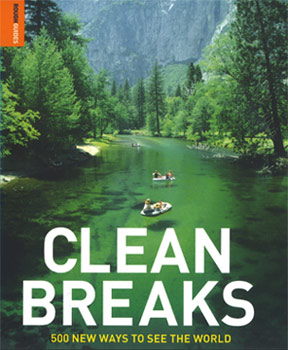MAMBA READS: HOLIDAYING WITH A CONSCIENCE
 You’ve heard of couch potatoes, and you’ve heard of armchair sportsmen. Well, I have to confess that I’m a bit of an armchair traveller. I have a fetish for travel books, even though I rarely – or almost never – get a chance to actually visit the exotic resorts splashed all over those glossy pages. In my world, the ultimate test for a good travel guide is that it should fill me with an irrational desire to quit my job and run away to someplace beautiful.
You’ve heard of couch potatoes, and you’ve heard of armchair sportsmen. Well, I have to confess that I’m a bit of an armchair traveller. I have a fetish for travel books, even though I rarely – or almost never – get a chance to actually visit the exotic resorts splashed all over those glossy pages. In my world, the ultimate test for a good travel guide is that it should fill me with an irrational desire to quit my job and run away to someplace beautiful.
A silly urge, I know, but we armchair travellers can dream too, can’t we? And as far as travel books are concerned, the latest title in the Rough Guides series, Clean Breaks – 500 new ways to see the world, is right up there with my favourite far-out fantasies.
What puts this whopper of a 391-page travel guide in a class of its own is the subtlety of its green angle. There’s no need to start cringing in anticipation of a barrage of bunny-hugging clichés and enviro-sermons. The book simply presents the reader with no less than 500 amazing and off-the-beaten-track ideas for holidaying with a conscience.
In fact, British freelance writer Jeremy Smith, who co-authored the guide with travel journo Richard Hammond (not the Top Gear presenter), emphasises that the guide does not set out to be preachy or militant about green issues at all. That’s why there is no mention of “eco-tourism” or “environmentally friendly getaways” on the cover.
By deliberately underplaying the eco-angle, the book shows that one does not need to be chained to an oil company’s front gate, count marmosets or go on hunger strikes to do your bit for the planet. “There is enough negativity and preaching out there,” says Smith. “We simply want people to start thinking about their holidays in new and exciting ways, which also just happen to have a gentler impact on the environment.”
And read this carefully: a smaller carbon footprint does not necessarily mean low on comfort or low on fun. Quite the opposite. The book covers the entire spectrum of possibilities on a cross-axis: from low-budget rustic, to five-star pampering; from restful and peaceful, to adventurous and strenuous. Just pitch your holiday at a comfort level you’re happy with and match it with activities you feel up to. How about a “rail and sail” trip from London to Dublin? Or if you’re a foodie, why not enjoy feasting at Salone Del Gusto in Italy – the world’s largest farmers’ market that lasts for five days?
There are festivals and gatherings aplenty, and places to stay include everything from mountain cabins and tepee villages, to river barges and bush lodges. For animal lovers, a host of endangered creatures are there to be admired and helped, from tracking cheetahs on foot in Namibia or wild dogs in Limpopo, to watching humpbacks breach in Hawaii or river dolphins side-swimming in Pakistan.
 The guide is conveniently divided into larger, colour-coded sections covering fourteen international regions, each with its own map that pinpoints the various holiday locations in that area. A large portion of the inserts are activity-based, and all of them provide the necessary contact details to start making your arrangements. Each insert also strikes a careful balance in terms of its readability: descriptive and enticing without becoming longwinded and cheesy; helpful and informative without becoming boring, and a dollop of humour here and there to liven things up a bit.
The guide is conveniently divided into larger, colour-coded sections covering fourteen international regions, each with its own map that pinpoints the various holiday locations in that area. A large portion of the inserts are activity-based, and all of them provide the necessary contact details to start making your arrangements. Each insert also strikes a careful balance in terms of its readability: descriptive and enticing without becoming longwinded and cheesy; helpful and informative without becoming boring, and a dollop of humour here and there to liven things up a bit.
If you really want to go green in terms of getting there, skip on the carbon-expensive airfares and plan a shared road trip in southern Africa. Although there is still a lot to be done in terms of awareness and attitudes everywhere, Smith believes that South Africa is at the forefront of concepts such as community-based eco-tourism. Even if you can’t afford an international, or even a national holiday, simply visiting and supporting tourism initiatives in your own area can help to plough something back into the communities that benefit from them.
But if you’re running low on leave and spare time and simply wish to escape in the comfort of your own armchair – which is unfortunately the rat-race reality for most of us – then get yourself this guide and find consolation in noting that it is printed on paper from sustainable sources and in ink that won’t stick around until the next ice age. Sit back, read, relax, and dream of the day your solar-powered ship glides in and your time is entirely your own.
Leave a Reply